Rajasthan Board RBSE Class 12 Maths Chapter 15 Linear Programming Miscellaneous Exercise
Solve the following linear programming problem by graphical method :
Question 1.
Maximize Z = 4x + y
Subject to the constraints,
x + y ≤ 50
3x + y ≤ 90
and x ≥ 0, y ≥ 0
Solution:
Converting the given inequations into equations
x + y = 50 …..(1)
3x + y = 90 …..(2)
Region represented by x + y ≤ 50 : The line x + y = 50 meets the coordinate axis at A(50, 0) and B(0, 50).
x + y = 50
| X | 50 | 0 |
| y | 0 | 50 |
A(50, 0); B(0, 50)
Join the points A and 5 to obtain the line. Clearly (0, 0) satisfies the inequation x + y ≤ 50. So, the region containing the origin represents the solution set of this inequation.
Region represented by 3x + y ≤ 90: The line 3x + y = 90 meets the coordinate axis at the points C(30, 0) and D(0, 90).
3x + y = 90
| X | 30 | 0 |
| y | 0 | 90 |
C(30, 0); D(0, 90)
Region represented by x ≥ 0 and y ≥ 0 : Since every point in the first quadrant satisfies these inequations. So, the first quadrant is the region represented by the inequation x ≥ 0 and y ≥ 0.
The shaded region OCEB represents the common region of the above inequations. This region is the feasible region of the given LPP.
E(20, 30) is the point of intersection of the lines x + y = 50 and lines 3x + y = 90.
The coordinates of this region of solution are O(0, 0), C(30, 0), E(20, 30) and B(0, 50).
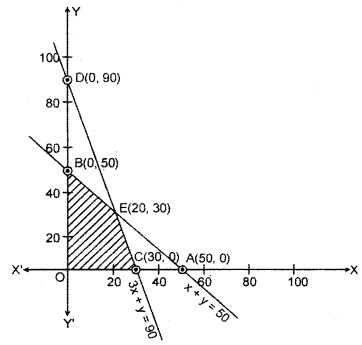
The value of objective function on these points are given in this table :
| Point | x-coordinate | y-coordinate | Objective function Z = 4x + y |
| O | 0 | 0 | ZO = 4(0) + (0) = 0 |
| C | 30 | 0 | ZC = 4(30) + 0 = 120 |
| E | 20 | 30 | ZE = 4(20) + 30 = 110 |
| B | 0 | 50 | ZB = 4(0) + 50 = 50 |
It is clear from the table that objective fucntion is maximum on point C(30, 0). Hence maximum value of Z = 120.
Question 2.
Minimize Z = 3x + 2y
Subject to the constraints
x + y ≥ 8
3x + 5y ≤ 15
and x ≥ 0,y ≤ 15
Solution:
Converting the given inequations into the equations :
x + y = 8 …..(1)
3x + 5y = 15 …..(2)
y = 15 …..(3)
Region represented by x + y ≥ 8 : The line x + y = 8 meets the coordinate axis at C(8,0) and D(0, 8).
Table for x + y = 8
| X | 8 | 0 |
| y | 0 | 8 |
A(8, 0); B(0, 8)
Join the points C and D to obtain the line. We find that the point (0, 0) does not satisfy the inequation x + y > 8. So, the region opposite to the origin represents the solution set to the inequation.
Region represented by 3x + 5y ≤ 15 : The line 3x + 5y = 15 meets the coordinate axis at C(5,0) and D(0, 3).
Table for 3x + 5y = 15
| X | 5 | 0 |
| y | 0 | 3 |
C(5,0);D(0,3)
Join the points C and D to obtain the line. Clearly (0,0) satisfies the inequation 3x + 5y ≤ 15. So, the region containing the origin represents the solution set of this inequation.
Region represented by y ≤ 15 : Line y = 15 is parallel to x-axis, its each point will satisfy the ineqnation in first quadrant. So, its solution region will be towards origin.
Region represented by x ≥ 0 and y ≥ 0 : Since every point in the first quadrant satisfies these inequations. So the first quadrant is the region represented by the inequations x ≥ 0 and y ≥ 0.
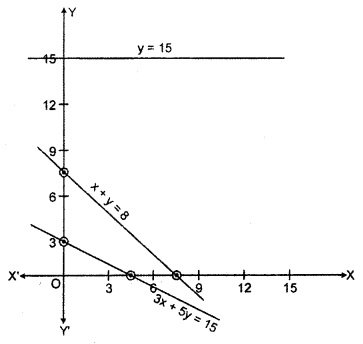
There is no any common region for solution.
Hence there is no feasible solution of this problem.
Question 3.
Minimize and maximize Z = x + 2y
Subject to the constraints,
x + 2y ≥ 100
2x – y ≤ 0
2x + y ≤ 200
and x ≥ 0,y ≥ 0
Solution:
Converting the given inequations into equations
x + 2y = 100 …..(1)
2x – y = 0 …..(2)
2x + y = 200 …..(3)
x = 0 …..(4)
y = 0 …..(5)
Region represented by x + 2y ≥ 100 : The line x + 2y = 100 meets the coordinate axis at A(10,0) and 5(0, 5).
Table for x + 2y = 100
| X | 100 | 0 |
| y | 0 | 50 |
A(100, 0); B(0, 50)
Join the points A and B to obtain the line. We find that the point (0, 0) does not satisfy the inequation x + 2y ≥ 100. So, the region opposite to the origin represents the solution set of the inequation.
Region represented by 2x – y ≤ 0: The line 2x – y = 0 meets the coordinate points at C(0, 0) and D( 100, 200).
2x – y = 0
| X | 0 | 100 |
| y | 0 | 200 |
C(0, 0), D(100, 200)
Join the points C(0,0) to D(100, 200) to obtain the line. Clearly (0, 0) satisfies. The inequation 2(0) – 0 = 0 ≤ 0. So the region containing origin represents the solution set of the inequation.
Region represent by 2x + y ≤ 200 : The line 2x + y = 200 meets the coordinate axis at ,A(100,0) and B(0, 200).
2x + y = 200
| X | 100 | 0 |
| y | 0 | 200 |
E(100, 0); F(0, 200)
Join points E and F to obtain the line. Clearly (0, 0) satisfies the inequation 2x + y ≤ 200. So the region containing the origin represents the solution set of this inequation.
Region represented by x ≥ 0 and y ≥ 0 : Since eveiy point in the first quadrant satisfies these inequations. So the first quadrant is the region represented by the inequations x ≥ 0 and y ≥ 0.
The shaded region BEFD represents the common region of the above inequations. This region is the feasible region of the given LPP.
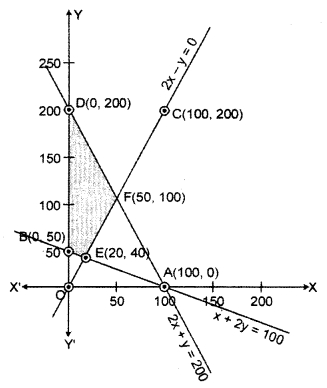
where point E(20,40) is the point of intersection of lines x + 2y = 100 and 2x – y = 0.
Point F(50, 100) is the point of intersection of lines 2x + y = 200 and 2x – y = 0.
The value of objective function on these comer points of feasible region are E(20, 40), B(0, 50), D(0, 200) and F(50, 100).
| Point | x-coordinate | y-coordinate | Objective function Z = x + 2y |
| E | 20 | 40 | ZE = 20 + 2 x 40 = 100 |
| B | 0 | 50 | ZB = 0 + 2 x 50 = 100 |
| F | 50 | 100 | ZF = 50 + 2 x 100 = 250 |
| D | 0 | 200 | ZD = 0 + 2 x 200 = 400 |
It is clear from the table that minimum value of objective function is = 100 at points E(20, 40) and B(0, 50) which is minimum on every point on line AEB and maximum value of objective function is on the point D(0, 200) where Z = 400.
Hence Minimum value of Z = 100
and Maximum value of Z = 400.
Question 4.
Maximize Z = 3x + 2y
Subject to the constraints
x + 2y ≤ 10
3x + y ≤ 15
and x ≥ 0,y ≥ 0
Solution:
Converting the given inequation into the equations
x + 2y = 10
3 x + y = 15
x = 0
y = o
Region represented by x + 2y ≤ 10 : The line x + 2y = 10, meets the coordinate axis at A(10, 0) and B(0, 5).
x + 2y = 10
| X | 10 | 0 |
| y | 0 | 5 |
A(10,0);B(0,5)
Join point A(10,0) to B(0,5) to obtain the line. Since the origin (0,0) satisfies the inequation 0 + 2(0) = 0 ≤ 10. So the region containing origin represents the solution set of the equation.
Region represented by 3x + y ≤ 15 : The line 3x + y = 15 meets the coordinate axis on points C(5,0) and D(0, 15).
3x + y = 15
| X | 5 | 0 |
| y | 0 | 15 |
C(5, 0); D(0, 15)
Join point C(5, 0) and D(0, 15) to obtain the line. Since the origin (0, 0) satisfies the given inequation 3(0) + 0 = 0 ≤ 15. So the region containing the origin, represent the solution set of the inequation.
Region represented by x ≥ 0,y ≥ 0 : Since every point in first quadrant, satisfies the inequation. So the first quadrant is the region represented by the inequations x ≥ 0 and y ≥ 0.
The point of intersection of the lines x + 2y = 10 and 3x + y = 15 is E where x = 4 and y = 3.
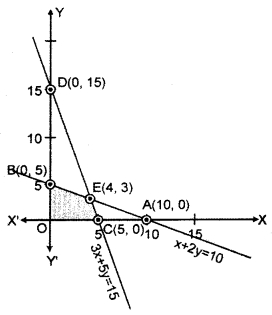
Shaded region OCEB represents the common region of the inequations. This region is the feasible solution region of the Linear Programming Problem.
The corner points of this common region are O(0, 0), C(5, 0), E(4, 3) and B(0, 5).
The value of objective function on these points is as the following table :
| Point | x-coordinate | y-coordinate | Objective function Z = 3x + 2y |
| O | 0 | 0 | ZO = 3(0) + 2(0) = 0 |
| C | 5 | 0 | ZC = 3(5) + 2(0) = 15 |
| E | 4 | 3 | ZE = 3(4) + 2(3) = 18 |
| B | 0 | 5 | ZB =3(0)+ 2(5) = 10 |
From the table Z = 3x + 2y is maximum at E(4, 3). Hence, maximum value of Z = 18.
Question 5.
A diet of a sick person must contain at least 4000 units of vitamins, 50 units of minerals and 1400 of calories. Two foods A and B are available at a costs ₹ 4 and ₹ 3 per unit respectively. If one unit of A contains 200 unit of vitamin, 1 unit of mineral and 40 calories and one unit of B contains 100 unit of vitamin, 2 unit of minerals and 40 calories, find what combination of foods should be used to have the least cost ?
Solution:
Let x unit of food A and y unit of food B are taken in combination of food.
∴ According to question,
Objective function to get minimum cost of combination is
Z = 4x + 3y
Constraints in problem :
For vitamin 200x + 100y ≥ 4000
For mineral x + 2y ≥ 50
and for Calorier 40x + 40y ≥ 1400
∵ x and y are quantity.
∴ x ≥ 0 andy ≥ 0
Converting the given inequations into the equations
200x + 100y = 4000
⇒ 2x + y = 40 …..(1)
x + 2y = 50 …..(2)
40x + 40y = 1400
⇒ x + y = 35 …..(3)
x= 0 …..(4)
y = 0 …..(5)
Region represented by 200x + 100y ≥ 4000 : The line 2x + y = 40 meets the coordinate axis at points A(20, 0) and B(0, 40).
2x + y = 40
| X | 20 | 0 |
| y | 0 | 40 |
A(20, 0); B(0, 40)
Join points A and B to obtain the line. Since the origin (0, 0) does not satisfy the given inequation 2(0) + 0 = 0 ≥ 40. So the region opposite to the origin represents the solution set of the inequations.
Region represented by x + 2y ≥ 50 : The line x + 2y = 50 meets the coordinate axis on the points C(50, 0) and D(0, 25).
x + 2y = 50
| X | 50 | 0 |
| y | 0 | 25 |
C(50, 0);D(0, 25)
Join points C(50,0) and D(0,25) to obtain the line. Since the origin (0, 0) does not satisfy the given inequation 0 + 2(0) = 0 ≥ 50. So the solution set of the inequation in opposite to the origin.
Region represented by x + y ≥ 35 : The line x + y = 35 meets the coordinate axis are C(35, 0) and D(0, 35).
x + y = 35
| X | 35 | 0 |
| y | 0 | 35 |
E(35, 0); F(0, 35)
Join the points E and F to obtain the line. Clearly (0, 0) does not satisfy the inequation x + y ≥ 35. So, the region opposite to the origin represents the solution set of this inequation.
Region represented by x ≥ 0 and y ≥ 0 : Since every point in the first quadrant satisfies the inequations. So the first quadrant represents the solution set of the inequations x ≥ 0 and y ≥ 0.
The coordinates of the point of intersection of lines 2x + y = 40and x + 2y = 50 are x = 10 and y = 20.
The coordinates of the point of intersection of lines x + 2y = 50 and x + y = 35 are x = 20 and y = 15 and the coordinates of the point of intersection of lines 2x + y = 40 are x + y = 35 and x = 5 and y = 30.
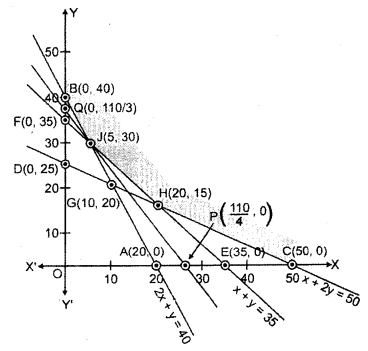
The shaded region CHJB represents the common region of the inequations. This is an open feasible solution region whose coordinates of the corner points are C(50, 0), H(20, 15), J(5, 30) and 5(0, 40).
The values of objective function on these points are given in the following table :
| Point | x-coordinate | y-coordinate | Objective function Z = 4x + 3y |
| C | 50 | 0 | ZC = 4(50) + 3(0) = 200 |
| H | 20 | 15 | ZH = 4(20)+ 3(15) = 125 |
| J | 5 | 30 | ZJ = 4(5) + 3(30) = 110 |
| B | 0 | 40 | ZB = 4(0) + 3(40) = 120 |
From table the value of Z is minimum at point J(5, 30) which is 110.
∵ Feasible region is open, so on plotting the graph of line 4x + 3y = 110 which is an open feasible semi region which have a common point J(5,30).
Hence the proper solution of LPP is point J(5, 30) to get the minimum price of combination.
The minimum price of combination is ₹ 110 and combination has food A = 5 unit and food B = 30 unit.
Question 6.
A diet is to contain at least 80 unit of vitamin A and 100 unit of minerals. Two foods F1 and F2 are available. Food F1 costs ₹ 4 per unit and F2 costs ₹ 6 per unit. One unit of food F1 contains 3 unit of vitamin A and 4 unit of minerals. One unit of food F2 contains 6 unit of vitamin A and 3 unit of minerals. Formulate this as a linear programming problem and find graphically the minimum cost for diet that consists of mixture of these foods and also meets the mineral nutritional requirements.
Solution:
Let x unit of food F1 and y unit of food F2 are required to get the minimum cost and minimum mineral nutritional requirements.
The cost of food F1 at the rate of ₹4 per unit = ₹4x and the cost of food F2 at the rate of ₹6 per unit = ₹6y
∴ Minimum cost of combined food = ₹ (4x + 6y)
The vitamin A in food F1 = 3x unit and vitamin A in food F2 = 6y unit.
∴ According to question,
3x + 6y ≥ 80
Similarly mineral in food F1 = 4x unit
and mineral in food F2 = 3y unit
∴ According to question
4x + 3y ≥ 100
x and y are quantity of food.
∴ x ≥ 0 and y ≥ 0
Therefore the mathematical formulation of Linear Programming Problem is as following :
Minimum Z = 4x + 6y
Subject to the constraints
3x + 6 ≥ 80
4x + 3y ≥ 100
x ≥ 0, y ≥ 0
Converting the inequations into the equation
3x + 6y = 80 …..(1)
4x + 3y = 100 ……(2)
Region represented by 3x + 6y ≥ 80 : The line 3x + 6y = 80 meets the coordinate axis at the points A(80/3,0) and B(0,40/3).
Table for 3x + 6y = 80
| X | 80/3 | 0 |
| y | 0 | 40/3 |
A(80/3,0); B(0,40/3)
Join the points A(80/3, 0) and B(0, 40/3) to obtain the line. Since the origin (0, 0) does not satisfy the inequation 3(0) + 6(0) = 0 ≥ 80. So the solution region of the inequation is in opposite of origin.
Region represented by 4x + 3y ≥ 100 : The line 4x + 3y = 100 meets the coordinate axis at the points C(25, 0) and D(0,\(\frac { 100 }{ 3 } \))
Table for 4x + 3y = 100
| X | 25 | 0 |
| y | 0 | 100/3 |
C(25,0);D(0,\(\frac { 100 }{ 3 } \))
Join points C and D to obtain the line. Since the origin (0, 0) does not satisfy the inequation 4(0) + 3(0) = 0 ≥ 100. So the solution region of the inequation is in opposite to origin.
Region represented by x ≥ 0 and y ≥ 0 : Since every point in the first quadrant satisfy the inequations. So the first quadrant represents the solution set of the inquations.
The point of intersection of lines 3x + 6y = 80 and 4x + 3y = 100 is E(24, 4/3).
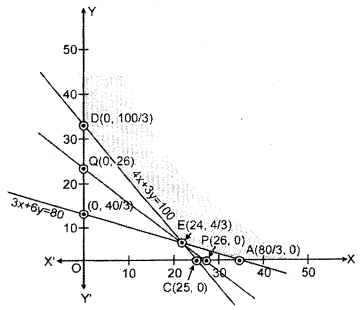
The shaded region AED is the common region of the inequations. This is an open feasible solution region.
The corner points of this open feasible region are A(80/ 3, 0), E(24. 4/3) and D(0, 100/3).
The values of object function on these comer points are given in the table:
| Point | x-coordinate | y-coordinate | Objective function Z = 4x + 6y |
| A | 80/3 | 0 | ZA = 4 x 80/3 + 6 x 0 = 106.66 |
| E | 24 | 4/3 | ZE = 4 x 24 + 6 x 4/3 = 104 |
| D | 0 | 100/3 | ZD = 4 x 0 + 6 x 100/3 = 200 |
The minimum value of Z = 104 at point E(24, 4/3).
∵ Feasible region is an open region so the inequation 4x + 6y ≤ 104 is satisfied by point E(24, 4/3).
Hence the combination of food consists 24 unit of food F1 and 4/3 unit of food F2 to get the minimum price ₹104.
Question 7.
A manufacturer of furniture makes two products : chairs and tables. Processing of these product is done on two machines A and B. One chair requires 2 hrs on machine A and 6 hrs on machine B. One table requires 4 hrs on machine A and 3 hrs on machine B. There are 16 hrs of time per day available on machine A and 30 hrs on machine B. Profit gained by the manufacturer from a chair and a table is ₹ 3 and ₹ 5 respectively. Find with the help of graph, what should be the daily production of each of the both products so as to maximize his profit ?
Solution:
Let the manufacturer should produce x chair and y tables per day.
∴ Total profit of manufacturer = ₹ (3x + 5y)
Time taken to prepare x chairs on machine A = 2x hrs and on machine B = 6x hrs
Time taken to prepare y tables on machine A = 4y hrs and on machine B = 2y hrs
∴ For time taken on machine A
2x + 4y ≤ 16 hrs
and time taken on machine B
6x + 3y ≤ 30 hrs
∴ x ≥ 0 and y ≥ 0
According to question mathematically formulation of Linear Programming Problem is as following :
Maximize Z = 3x + 5y
Subject to the constraints
2x + 4y ≤ 16
6x + 3y ≤ 30
x ≥ 0 and y ≥ 0
Converting the given inequations into the equations
2x + 4y = 16
6x + 3y = 30
Region represented by 2x + 4y ≤ 16 : The line 2x + 4y = 16 meets the coordinate axis on the points A(8,0) and B(0, 4).
Table for 2x + 4y = 16
| X | 8 | 0 |
| y | 0 | 4 |
A(8, 0); B(0, 4)
Join the points A and B to obtain the line. Since (0, 0) satisfies the inequation 2(0) + 4(0) ≤ 16 so the region containing the origin represents the solution set of the inequation.
Region represented by 6x + 3y ≤ 30 : The line 6x + 3y = 30 meets the coordinate axis on the points C(5,0) and D(0, 10).
Table for 6x + 2y = 30
| X | 5 | 0 |
| y | 0 | 10 |
C(5,0);D(0,10)
Join the points C and D to obtain the line. Since the origin (0, 0) satisfies the inequation 6(0) + 2(0) = 0 < 30. So the region containing the origin represents the solution set of the inequation.
Region represented by x ≥ 0 and y ≥ 0: Since the every point of first quadrant satisfies these inequations. So the first quadrant is the solution set of the inequations.
The point of intersection of lines 2x + 4y = 16 and 6x + 3y = 30 is E(4, 2) where x = 4 and y = 2.
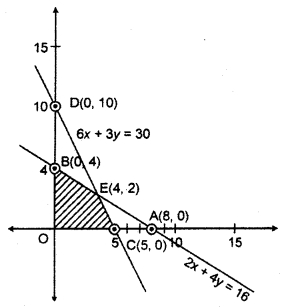
The shaded region OCEB represents the common region of inequations. This region represents the feasible solution. The comer points of this region are O(0, 0), C(5,0), E(4, 2) and B(0, 4).
The value of objective function on these points is given in the following table :
| Point | x-coordinate | y-coordinate | Objective function |
| O | 0 | 0 | ZO = 3(0) + 5(0) = 0 |
| C | 5 | 0 | ZC = 3(5) + 5(0) = 15 |
| E | 4 | 2 | ZE = 3(4) + 5(2) = 22 |
| B | 0 | 4 | ZB = 3(0) + 4(2) = 8 |
From the table, the value of objective function is maximum on the point E(4,2) where x = 4 and y = 2.
Hence to get the maximum profit of ₹ 22, manufacturer should produce 4 chairs and 2 tables.
Question 8.
A firm manufactures headache pills in two sizes A and B. Size A contains 2 grams of aspirin 5 grams of bicarbonate and 1 gram of cofeine; size B contains 1 grams of asprin of 8 grms of bicarbonate and 6 grains of cofeine. It has been found by users that it requires atleast 12 grams of aspirin 74 grams of bicarbonate and 24 grams of cofeine for providing immediate effects. Deternfine graphically the least number of pills a patient should have to get immediate relief.
Solution:
Let the patient should have x pills of size A and y pills of size B.
∴ Maximum number of pills = x + y
According to question,
A type pills have quantity of Aspirin = 2x gramn and B type pills have quantity of Aspirin = 1 y grams
∴ Constraints for quantity of Aspirin
2x + y ≥ 12 grams
Similarly constraints for Bicarbonate
5x + 8 ≥ 74 grams
and constraints for quantity of cofeine
x + 6.6y ≥ 24 grams
∵ x and y are the number of pills.
∴ x ≥ 0 and y ≥ 0
So mathematical formulation of linear programming problem is the following :
Minimize Z = x + y
Subject to the constraints
2x + y ≥ 12
5x + 8 ≥ 74
x + 6y ≥ 24
x ≥ 0, y ≥ 0
Converting the constraints into the equations
2x + y = 12 …..(1)
5x + 8y = 74 …..(2)
x + 6y = 24 …..(3)
Region represented by 2x + y ≥ 12 : The line 2x + y = 12 meets the coordinate axis at the points A(6,0) and B(0, 12).
Table for 2x + y = 12
| X | 6 | 0 |
| y | 0 | 12 |
A(6,0); B(0, 12)
Join the point A to 5 to obtain the line. Since the origin (0, 0) does not satisfy the inequation 2(0) + (0) = 0 ≥ 12. So the region opposite to origin represents the solution set of the inequation.
Region represented by 5x + 8y ≥ 74 : The line 5x + 8y = 74 meets the coordinate axis at the point C(74/5, 0) and D(0, 74/8).
Tabel for 5x + 8y = 74
| X | 74/5 | 0 |
| y | 0 | 74/8 |
Join the points C and D to obtain the line. Since the origin (0,0) does not satisfy the inequation 5(0) + 8(0) ≥ 74. So the region opposite to origin represents the solution set of inequation.
Region represented by x + 6y ≥ 24 : The line x + 6.6y = 24 meets the coordinate axis at the point E(24,0) and F(0,4).
The table for x + 6y = 24
| X | 24 | 0 |
| y | 0 | 4 |
A(24, 0); B(0, 4)
Join the points E and F to obtain the line. Since the origin (0, 0) does not satisfy the inequation. So the region opposite to origin represents the solution set of the inequation.
Region represented by x ≥ 0, y ≥ 0 : Since every point in first quadrant satisfies the inequations so the first quadrant represents the solution set of these inequations.
The point of intersection of lines 2x +y – 12 and 5x + 8y = 74 is G(2, 8).
The point of intersection of lines 5x + 8y = 74 and x + 6y = 24 is H (\(\frac { 126 }{ 11 } \),\(\frac { 23 }{ 11 } \)).
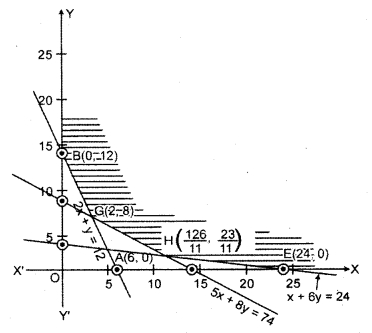
The shaded region BGHE is the common region of the inequations. This is an open feasible region of solution.
The corner points of this open feasible solution region
are B(0, 12), G(2, 8), H(\(\frac { 126 }{ 11 } \),\(\frac { 23 }{ 11 } \)) and E(24, 0).
The values of objective function on these comer points are given in the following table :
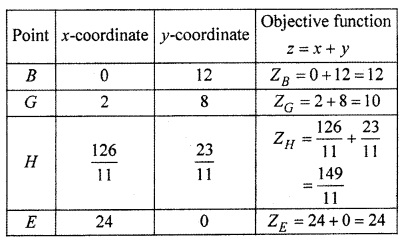
From the above table the value of objective function is minimum at the point G(2, 8) where x = 2 and y = 8 and z = 2 + 8 = 10.
Since feasible region of solution set is an open region. So the graph of x + y ≤ 10 passes through point G(2,8) which satisfies the inequation z + 8 = 10 so the solution of this LPP is G(2, 8) where x = 2 and y = 8.
Hence the patient should have minimum 2 pills of type A and 8 pills of type B to get immediate relax.
Question 9.
A brick manufacturer has two depots A and B with stocks of 30,000 and 20,000 bricks respectively. He receives order from the builders P, Q and R for 15000, 20,000 and 15,000 bricks respectively. The cost in rupee transporting 1000 bricks to the builders from the depots are given below :
| To/From | P | Q | R |
| A | 40 | 20 | 30 |
| B | 20 | 60 | 40 |
How should the manufacturer fulfill the orders so as to keep the cost of transporation minimum ?
Solution:
Let Depot A supplies x thousand bricks to builder P and y thousand to builder Q. Then remaining bricks (30 – x – y) will be supplied to builder R.
Therefore cost of transportation from builder A to builder P, Q and R are ₹40x, ₹20y and ₹ 30(30 – x – y) respectively.
From Depot B the number of bricks supplied to builder P = (15 – x) thousand
Number of bricks supplied to builder Q = (20 – y)
and the number of bricks supplied to builder R = 20 – (15 – x + 20 – y) = (x + y – 15)
Therefore the cost of transportation from depot B to builders P, Q and R are ₹20(15 -x), ₹60(20 -x) and ₹40(x + y – 15). So the total cost of transportation from both Depots A and B to the builders P,Q and R.
Z = 40x + 20y + 30(30 – x – y) + 20(15 – x) + 60(20 – y) + 40(x + y – 15)
= 30x – 30y + 1800
Therefore mathematical formulation of Linear Programming Problem is the following
Minimize Z = 30x – 30y + 1800
Subject to the constraints
x + y ≤ 30
x ≤ 15
y ≤ 20
x + y ≥ 15
x ≥ 0
y ≥ 0
Converting the given inequations into the equations :
x + y = 30 ……(1)
x = 15 …..(2)
y = 20 …..(3)
x + y = 15 …..(4)
x = 0 …..(5)
y = 0 …..(6)
Region represented by x + y ≤ 30 : The line x + y = 30,meets the coordinate axis at ,A(30, 0) and B(0, 30).
| X | 30 | 0 |
| y | 0 | 30 |
A(30,0);B(0,30)
Join the points A and B to obtain the line. Clearly (0,0), satisfies the inequation 0 + 0 ≤ 30. So the region containing the origin represents the solution set of the inequation.
Region represented by x ≤ 15: The line x = 15 is parallel toy-axis and its every point will satisfy the inequation in first quadrant. The region containing the origin represents the solution set of the inequation.
Region represented by y ≤ 20: The line y = 20 is parallel to x-axis and its every point will satisfy the inequation in first quadrant.
Region represented by x + y ≥ 15 : The line x + y = 15 meets the coordinate axis at the points C(15, 0) and D(0, 15).
x + y = 15
| X | 15 | 0 |
| y | 0 | 15 |
C(15, 0); D(0, 15)
Join the points C to D to obtain the line. Since the origin (0, 0) does not satisfy the inequation 0 + 0 = 0 ≥ 15. So the region opposite to the origin represents the solution set of inequations.
Region represented by x ≥ 0 and y ≥ 0 : Since every point in first quadrant satisfy the inequation. So the first quadrant represents the solution of inequations x ≥ 0 and y ≥ 0.
The shaded region CJKED represents the feasible solution region of the inequation.
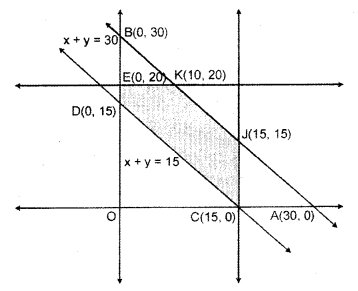
The corner points of this region are C(15, 0), J(15, 15), K(10,20), E(0,20) and D(0, 15) where point C(15, 0), J(15, 15), K(10,20), E(0,20) and D(0, 15) are point of intersection of respective lines.
The values of objective function on these comer points are given in the following table :
| Point | x-coordinate | y-coordinate | Objective function Z = 30x – 30y +1800 |
| C | 15 | 0 | ZC = 30 x 15 – 30 + 0 + 1800 = 2250 |
| J | 15 | 15 | ZJ = 30 x 15 – 30 x 15 + 1800 = 1800 |
| K | 10 | 20 | ZK = 30 x 10 – 30 x 20 + 1800 = 1500 |
| E | 0 | 20 | ZE = 30 x 0 – 30 x 20 + 1800 = 1200 minimum |
| D | 0 | 15 | ZD = 30 x 0 – 30 x 15 + 1800 = 1350 |
From the table it is clear that the value of objective function is minimum ₹ 1200 at point E(0, 20). So Depot A should deliver the bricks to buiders P, Q and R as 0, 20, 10 thousands and Depot B should deliver 15,0 and 5 thousands . respectively.
Hence,
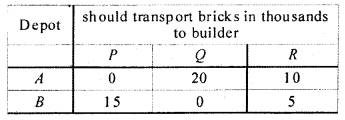
Question 10.
Region represented by the inequation system
x + y ≤ 3
y ≤ 6
and x ≥ 0,y ≥ 0
is :
(A) Unbounded in first quadrant
(B) Unbounded in first and second quadrant
(C) Bounded in first quadrant
(D) None of the above
Solution:
Converting the given inequations into equations
x + y = 3 …..(1)
y = 6 …..(2)
Region represented by x + y ≤ 3 : The line x + y = 3 meets the coordinate axes are A(3,0) and B(0,3) respectively,
x + y = 3
| X | 3 | 0 |
| y | 0 | 3 |
A(3, 0); B(0, 3)
Join points A and B to obtain the line. Clearly, (0, 0) satisfies the inequation x + y ≤ 3. So, the region containing the origin represent the solution set of the inequation.
Region represented by y ≤ 6 : The line y = 6 is parallel to x-axis and its every point will satisfy the inquation in first quadrant, region containing the origin represents the solution set of this inequation.
Region represented by x ≥ 0 and y ≥ 0 : Since every point in first quadrant satisfy the inequations, so the first quadrant is the solution set of these inequations.
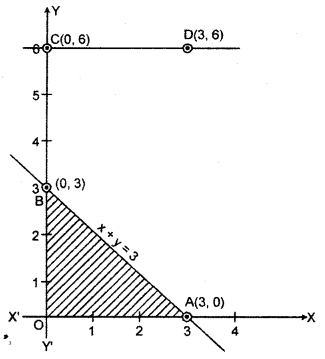
The shaded region is the common region of inequations. This is feasible region of solution which is bounded and is in first quadrant.
Hence the region is bounded and is in first quadrant.
∴ Answer (c) is correct.